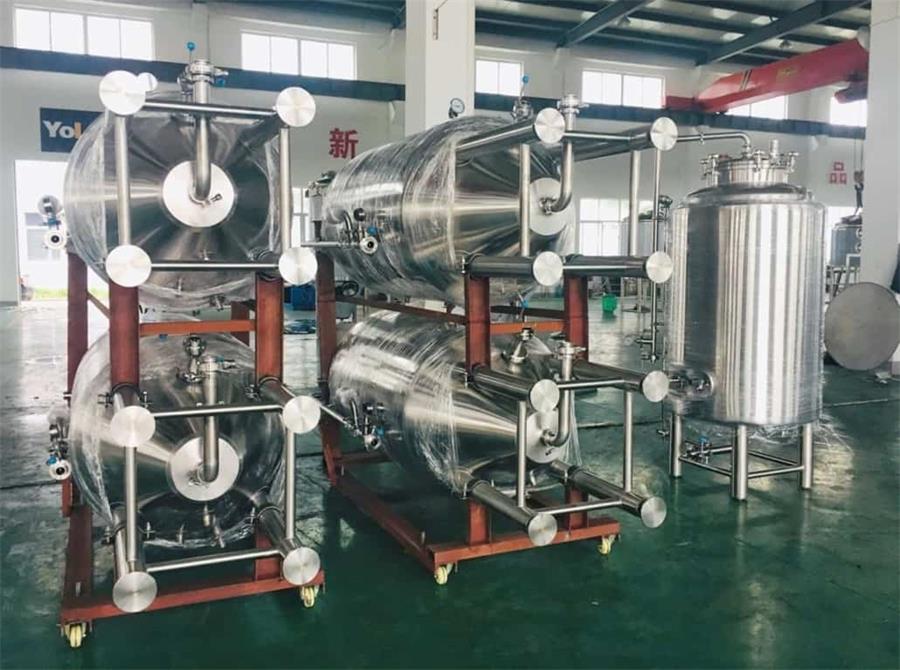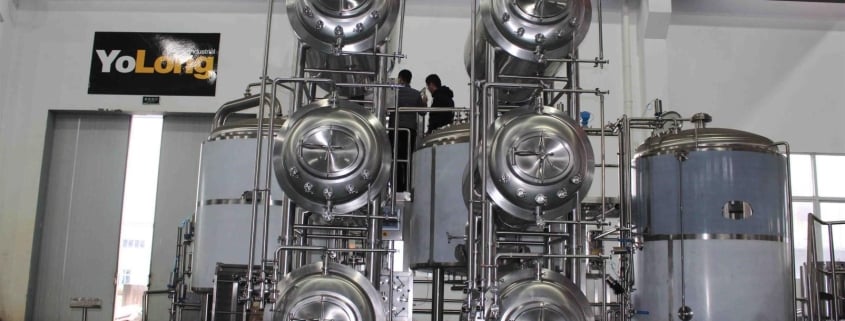7 BBL Mash Tun
A 7 BBL Mash Tun is a critical brewing system component, responsible for the mashing process which converts milled grain starches into fermentable sugars. This overview covers best practices for 7 barrel (BBL) mash tun selection, operation and maintenance to help craft brewers make informed decisions.
Key topics explored include mash tun types, sizing considerations, manufacturing customization options, leading equipment suppliers, installation and cleaning procedures, and comparing the pros and cons of different tun configurations across a range of criteria.
Overview of 7 BBL Mash Tuns
With brewhouse batch capacity rated at 7 barrels or 217 gallons (820 liters), a 7 BBL mash tun provides the optimal size for small to mid-size craft breweries. Key design goals include:
- Facilitating the mashing process by mixing hot water and grain
- Maintaining precise temperature control during mashing
- Allowing sparging to rinse sugars from grains post-mash
- Offering flexibility for different grain bills and beer recipes
- Easy cleaning and maintenance between batches
- Cost-effective and durable stainless steel construction
Mash efficiency and consistency are critical for quality beer production, making the mash tun an essential capital investment.

Types of 7 BBL Mash Tun Systems
Commercial mash tuns utilize either single infusion or multi-step infusion mashing processes. Batch or continuous flow designs impact layout and costs.
Mash Tun Configuration Types
Single Infusion Tuns
Simple insulated vessels with mixing capability. Hot water and grain soaked for 60-90 minutes.
Multi-Step Infusion Tuns
Allow more complex mashing profiles with adjustable temp rests to optimize sugar extraction.
Batch Mash Tuns
Most common design where entire mash takes place sequentially in the tun.
Continuous Mash Filters
Mash fed constantly into vessel and wort extracted in a flow through column design allowing very high volumes.
For craft-scale 7 BBL systems, single infusion tri-clover ferrule batch tuns offer the best flexibility and value.
7 BBL Tun Sizing Specifications
Properly sized mash tuns help ensure optimal quality and the ability to meet production quotas.
Key 7 BBL Mash Tun Specifications
| Specification | Details |
|---|---|
| Total Capacity | 8 BBL (31 cu ft) |
| Working Capacity | 7 BBL (27 cu ft) |
| Diameter | 42-48 inches |
| Height | 48-60 inches |
| Wall Thickness | 1.5 – 2.5 mm stainless |
| Material | 304 or 316 Stainless Steel |
The dimensions provide adequate space for grain bed expansion and water volumes needed while maximizing heat retention.
Customization & Options for Mash Tuns
While offering standard vessel shapes, most mash tun vendors provide wide customization flexibility during fabrication regarding dimensions, ports and fittings.
Mash Tun Feature & Component Options
Heating Elements
Electric immersion heating rods or steam jacket integrations available for supplementary heating capability
Insulation Layers
Optional insulation wrapping improves temperature hold times, saving energy and stabilization times
Automatic Sensors & Controls
Digital thermometer probes, PLC automation controls, flow meters can help increase precision
Rotating Rakings Arms
Interior rakes with automated actuators to stir the grain mash if desired
Custom Ports & Fittings
Tri-clover, cam-lock or threaded fittings; sight glasses, sample valves, racking adapters
Platforms & Stands
Provides a frame with casters to mount the tun off the ground for improved access
Overview of the Mashing Process
The mash tun facilitates key brewing processes critical for flavor including:
Milling – Crack open grain hulls to expose starch granules, increasing surface area. Must avoid pulverizing husks which create stuck mashes.
Mashing – Mixing milled grain with hot water in the mash tun to covert starches to fermentable sugars via natural enzymes. Temp held around 150°F.
Sparging – Gently rinsing sugar rich wort from grain bed after mashing completes using a spray nozzle.
Lautering – Recirculating and separating sweet wort from grains; filter bed allows clear separation.
Mash efficiency depends on uniform temperature maintenance, grain/water ratios, pH levels and avoiding a stuck mash.
7 BBL Tun Pricing from Leading Suppliers
As a foundational brewhouse component, investing in a quality mash tun protects product quality. Approximate pricing from commercial fabrication shops is summarized below.
7 BBL Mash Tun Pricing
| Tun Make & Model | Base Price Range |
|---|---|
| SS Brewtech InfuSsionMash 7BBL | $21,000 – $31,000 |
| Premier Stainless Batch7 | $19,000 – $27,000 |
| JV Northwest BM7 | $22,000 – $33,000 |
| AAA Metal MashMaster 7 | $18,000 – $26,000 |
Cost Considerations
Hardware & Controls
Pricing scales up depending on level of sensors, automation and precision wanted
Fabrication & Build
More exotic metals or specialized options increase overall system expense
Freight & Delivery
Tanks built overseas or far from brewery adds transport fees
Installation & Commissioning
Some vendors include guidance for integrating the tun into the brewery. Complex systems require additional charges.
Choosing a Reliable 7 BBL Tun Supplier
With specialty fabrication shops scattered globally, selecting the ideal mash tun vendor involves weighing several factors:
Key Mash Tun Supplier Evaluation Criteria
| Consideration | Decision Criteria |
|---|---|
| Mash Efficiency Track Record | • Documented efficiency with various grain bills <br> • Brewhouse integration success |
| Build Quality & Durability | • Welding and fabrication best practices <br>• Documented MTBF component lifetimes |
| Customization Capability | • Range of mash profiles and volumes supported <br>• Fitting, insulation and mount options |
| Company Heritage & Support Resources | • Years in business <br>• Staff engineering experience level |
| Customer Support Responsiveness | • Ticket resolution time commitments <br>• Support team brewing experience |
Thorough on-site visits to existing installations build trust in capabilities and quality.
Comparing Pros and Cons of 7 BBL Configurations
There are always tradeoffs to evaluate when selecting an optimal mash tun system.
Pros and Cons Comparison
| Pros | Cons | |
|---|---|---|
| Electric Infusion Tuns | • Lower upfront cost <br>• Simplified control scheme | • Lengthy heat up times <br> • Limited scalability |
| Steam-Jacketed Tuns | • Extremely precise temp control <br>• Fast heating response | • Added boiler dependencies <br>• Condensation side-reactions |
| Single-Step Infusion | • Simple, easy to use | • Less flexibility for recipes <br>• Lower maximum efficiency |
| Multi-Step Infusion | • Support complex mash profiles <br>• Increase max efficiency | • Increased cost <br>• Tun scheduling complexity |
| Top-Mounted Tun | • Self-draining into kettle <br>• Compact system footprint | • Access into tun more complex <br>• Max size constraints |
| Bottom-Mounted Tun | • Simplified inspection and cleaning <br>• Larger diameter tuns supported | • Additional floorspace |
Considering all brewing goals, recipes, and brewhouse layout constraints helps inform the optimal system.
Best Practices: Mash Tun Operation & Maintenance
Proper mash tun operation and preventative maintenance is vital for consistency and longevity. Best practices include:
- Thoroughly scrub and rinse the tun after each batch using approved chemicals
- Every 30 batches, deep clean the tun interior performing visual inspection
- Check steam jacket seals or electric heating elements for any leaks
- Confirm mash paddles or internal rakes turn freely without binding
- Inspect tun exterior welds and skin for pitting or cracks
- Replace worn gaskets and seals annually or immediately if leaks detected
- Lubricate tun vortex and sampling valves as needed
- Keep logs of efficiency metrics to diagnose issues early
An annual maintenance contract with specialized technicians supplements good habits for maximizing lifespan beyond 15-20 years.
FAQ
What is a typical mash schedule for a 7 BBL mash tun?
A standard mash profile is 60 minutes at 66°C, raised slowly to 72°C, held 30 minutes, then a mash-out rise to 78°C. Many variations possible depending on enzyme rests desired in the recipe.
How do brewers avoid a stuck mash in a mash tun?
Using rice hulls in the grain mix, proper grinde calibration, uniform heating without hot/cold spots, thin mash depth and correct pH helps avoid set mashes. Paddle agitation also reduces risks.
What is the typical thickness of the mash in a 7 BBL system?
Mash thickness between 1.25-1.5 quarts of water per pound of grain (2-2.5 liters/kg) provides an adequate compromise across metrics like extraction efficiency and lauter speed.
How much grain can a 7 BBL mash tun process per batch?
Up to 1000-1200 lbs (450-550 kg) is common, depending on grain bill ingredients and hot liquor ratios used. Lighter more wheat-heavy mixes allow more grain weight.
What are the most important parts of a mash tun to maintain?
The heating elements or steam jacket seals, automatic temperature sensors, and rotating mixing rakes (if used) require the most routine inspection and occasional replacement to avoid tun downtime. Catching gasket issues early is also critical.




